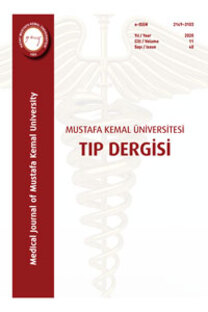ADLİ OLGU OLARAK DEĞERLENDİRİLEN TRAVMATİK DİŞ YARALANMALARI
Diş yaralanmaları, adli rapor, travma
Traumatic Tooth Injuries Evaluated as Forensic Cases
Tooth injuries, forensic report, trauma,
___
- Andreasen JO, Andreasen FM. Crown fractures. In: Andreasen JO, Andreasen FM, eds. Textbook and Color Atlas of Traumatic Injuries to the Teeth. 3rd ed. Copenhagen: Munksgaard;1994. p. 219- 56.
- Kargul B, Cağlar E, Tanboğa I: Dental trauma in Turkish children, Istanbul. Dent Traumatol. 2003;19(2):725
- Díaz JA, Bustos L, Brandt AC, Fernandez BE. Dental injuries among children and adolescents aged 1-15 years attending to public hospital in Temuco, Chile. Dent Traumatol. 2010;26(3):254-61
- Veire A, Nichols W, Urquiola R, Oueis H. Dental trauma: review of common dental injuries and their management in primary and permanent dentitions. J Mich Dent Assoc. 2012;94(1):41-5
- Garbin CA, Guimaraes E Queiroz AP, Rovida TA, Garbin AJ. Occurrence of traumatic dental injury in cases of domestic violence. Braz Dent J. 2012;23(1):72-6
- Sarıkaya I, Güler AU. Prosthodontic treatment of crown fractures with using fiber materials: case report. Türkiye Klinikleri J Dental Sci. 2009;15(3):234-40
- Ercan E, Dallı M, Dülgergil ÇT, Yaman F. Prevalence of trauma to anterior teeth among school children living Diyarbakır. Türkiye Klinikleri J Dental Sci. 2008; 14:12-7
- Burke FJT: Reattachment of a fractured central incisor tooth fragment. Br Dent J. 1991; 170(2): 223-5.
- Tümen EC, Çelenk S, Ağaçkıran E, Atakul F. An alternative treatment approach in anterior tooth fractures caused by trauma: a case report one year. Dental Journal of Dicle. 2010;11(1): 11-4
- Balcı Y, Güzel S, Çetin G. Türk Ceza Kanunu’nda tanımlanan yaralama ağırlıklarının adli tıp açısından değerlendirilmesi. 1. Baskı, İstanbul: Adli Tıp Kurumu Yayınları; 2013:11-28.
- Castro JC, Poi WR, Manfrin TM, Zina LG. Analysis of the crown fractures and crownroot fractures due to dental trauma assisted by the Integrated Clinic from 1992 to 2002.Dent Traumatol. 2005;21(3):121-6.
- Veire A, Nichols W, Urquiola R, Oueis H. Dental trauma: review of common dental injuries and their management in primary and permanent dentitions. J Mich Dent Assoc. 2012;94(1):41-5.
- Fariniuk LF, Souza MH, Westphalen VP, Carneiro E, Silva Neto UX, Roskamp L, et al. Evaluation of care of dentoalveolar trauma. J Appl Oral Sci. 2010;18(4):343-5.
- Silva AC, Passeri LA, Mazonetto R, Moraes M, Moreira RWF. Incidence of dental trauma in Brazil: a 1-year evalution. Dent Traumatol. 2004;20(1):6-11.
- Glendor U. Aetiology and risk factors related to traumatic dental injuries—a review of the literature. Dent Traumatol. 2009;25(1):19-31.
- Nicolau B, Marcenes W, Sheiham A. Prevalence, causes and correlates of traumatic dental injuries among 13-yearolds in Brazil. Dent Traumatol. 2001;17(5):213-7.
- Nicolau B, Marcenes W, Sheiham A. The relationship between traumatic dental injuries and adolescents' development along the life course. Community Dent Oral Epidemiol. 2003;31(4):306-13.
- Müller KE, Persic R, Pohl Y, Krastl G, Filippi A: Dental injuries in mountain biking-a survey in Switzerland, Austria, Germany and Italy. Dent Traumatol. 2008; 24 (2): 522–7.
- Emerich K, Kaczmarek J: First aid for dental trauma caused by sports activities: state of knowledge, treatment and prevention. Sports Med. 2010; 40(5): 361– 6.
- Gong Y, Xue L, Wang N, Wu C. Emergency dental injuries presented at the Beijing Stomatological Hospital in China. Dent Traumatol. 2011;27(3):203-7.
- ISSN: 2149-3103
- Yayın Aralığı: 3
- Başlangıç: 2010
- Yayıncı: Hatay Mustafa Kemal Üniversitesi Tıp Fakültesi Dekanlığı
Aripiprazol Sonrası Gelişen Diurnal Enürezis Hüseyin
ADLİ OLGU OLARAK DEĞERLENDİRİLEN TRAVMATİK DİŞ YARALANMALARI
Hiperkalemi ayırıcı tanısı: Yoğurt
ŞİZOFRENİ VE BİPOLAR BOZUKLUKLAR İLE ENFEKSİYON HASTALIKLARI ARASINDAKİ İLİŞKİNİN ARAŞTIRILMASI
YENİDOĞANDA NADİR BİR SOLUNUM SIKINTISI SEBEBİ: KONJENİTAL LOBER AMFİZEM
